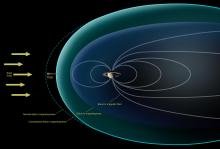Listen to today's episode of StarDate on the web the same day it airs in high-quality streaming audio without any extra ads or announcements. Choose a $8 one-month pass, or listen every day for a year for just $30.
You are here
Saturn at Opposition III
Saturn continues to shine at its best. The planet is low in the southeast at nightfall, to the lower left of brilliant Jupiter. Saturn looks like a bright golden star, and it’s in view all night.
Saturn looks so bright in part because of its rings. They’re tilted toward Earth right now, so they reflect more sunlight our way than the planet itself.
It’s easy to think of the rings as a single piece — like a spinning DVD or phonograph record. That’s far from the case, though. The rings consist of trillions of small bits of ice and rock. Each particle orbits the planet like a tiny moon.
That means the particles in different rings move at different speeds. The bits that are closer to Saturn move faster than those that are farther away.
The inner edge of the closest major ring, the C ring, is about 4,000 miles above the planet’s clouds. At that distance, a ring particle moves at about 53,000 miles per hour. That’s three times faster than the International Space Station orbits Earth. But a particle at the outer edge of the outermost major ring, the A ring, is about 50,000 miles from Saturn. At that distance, it orbits at 36,000 miles per hour.
So if you could paint a big red stripe across the top of the rings, from inner edge to outer edge, then watch what happened, the stripe wouldn’t last for long. The particles would quickly form an ever-tightening spiral — tiny moons spinning around a giant planet.





